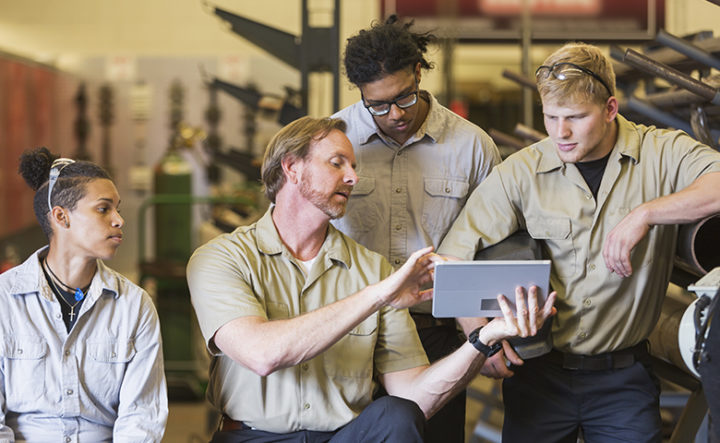What separates an average safety trainer from an exceptional one? You might be surprised to learn that personality traits can play a big role in training delivery. All good training sessions require well-thought out and practiced material, but it’s also important that the trainer plays to their strengths.
Safety trainers should continually improve their skills in order to speak to their audience and to meet the objective of the training—if you aren’t focusing on making the most of your natural strengths as a trainer then you will not get the results you desire. Take a look at these most popular traits and see where you fit in. If you want to dig a bit deeper, check out the ten most popular personal assessments.
Communicator

Communicators are flexible, open-minded, positive thinkers and they are often good with conflict resolution. For these reasons, a communicator is naturally a people-person. They are able to interact with people through verbal, non-verbal and visual forms like speaking, writing, eye contact and body language. The communicator is an active listener—instead of interrupting people to get their point across, they’ve mastered the skill of really listening to what others are saying. A good communicator will notice when their trainees do not understand and make an effort to find a way to get through to them. Their presentation style includes paraphrasing, repetition and presenting in multiple ways to ensure that the training objective is clear to all trainees.
Communicators often seek opportunities for collaboration. When the training session requires the trainees to give presentations, the communicator acts as a coach to get them through the delivery and improve their communication. Communicators are motivators and inspire trainees to be self-directed learners.
Techie

The techie doesn’t always work in the IT department as the name suggests, but they are passionate about using technology and typically have a stronger than average understanding of it. Techies have a compulsion to check emails, social media and text messages at any given opportunity to ensure they’re always up-to-date with the most current information. But that won’t interfere with their training—they are enthusiastic trainers. Techies are creative, out-of-the-box thinkers who are always seeking innovative ways to solve problems, a.k.a. learning opportunities. They can speak both techie and non-techie and they’re always willing to take extra time to teach others about technology for the benefit of the team and the ease of use going forward.
A techie will often be current with the latest technology and will try to find ways to incorporate it into the classroom whenever possible. A techie’s expectation of the training is a little higher than others, and subsequently, trainees will often strive to be better and you’ll notice they’re more willing to put in a little extra effort as a result. Since technology is constantly changing, techies are adaptable to define new approaches to training, keeping trainees engaged.
Nurturer

The nurturer enjoys helping others and often takes trainees under their wing. There is a personal element to training sessions that often incorporates a trainee’s well-being. The nurturer is open and welcoming, creating an approachable relationship that influences the trainees long after the training session is over. Trainees feel like the nurturer really cares about them and the nurturer is a trusted source of knowledge.
The nurturer is a people pleaser, dislikes conflict and has a hard time saying no. They always have a lot on the go and they often overcommit themselves to various activities for the sake of helping others. The nurturer has great self-awareness and social skills and often becomes friends with their trainees after the training session in order to foster their learning.
Scholar

The scholar believes that every point made in the training session can be substantiated with a stat, fact or article, and they often train as the subject matter expert. A great deal of research goes into a scholar’s training sessions and they are results oriented. Because of the educational aspect of the training, the scholar will often put some sort of assessment into training sessions to ensure their trainees’ understand the intended message.
Scholars are logical and critical thinkers who enjoy problem-solving. Scholars can also be a little autocratic in that they provide information for the lesson but do not expect trainees to contribute ideas. Training that is factual is well-suited to the scholar, as is training that requires a lot of supervision. Their training sessions don’t get off-track very often—they stick to the lesson plan and deliver the facts to direct learning outcomes.
Maintaining effective learning design and outcomes
Not all trainers will fit solely into one category. In fact, most trainers have traits from several categories, which can make them well-rounded trainers. Knowing how to capitalize on your traits will help you maximize engagement and retention. Adopting the most appropriate style will also enhance the learning experience for your participants. While you want to play to your strengths for impact, you need to be cognizant of learning best practices and embrace some of your weaker capabilities to maintain a balanced approach. You might be great with storytelling, but structuring an entire class around you talking isn’t going to be the best approach for learners. Break up your auditory strengths with visual elements, active learning exercises and group interactions.
Maintaining organizational consistency
In a large-scale or company-wide training initiative where multiple trainers may be required, it will be very important that all participants walk away with the same knowledge even if the delivery varied. Ideally, the trainer group will be working from the same script or work together on the learning design so there is a balance of activities that will allow each trainer to leverage their strengths while effectively communicating the topic. And as an additional check, it would be a good idea to incorporate some sort of evaluation or assessment following the training to ensure all participants have retained key points regardless of who trained them.

